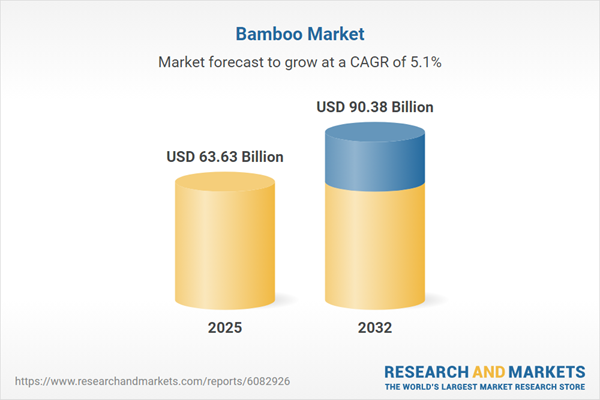Speak directly to the analyst to clarify any post sales queries you may have.
The bamboo market is evolving into a key driver of sustainable innovation, offering organizations a flexible, high-performance alternative to traditional materials. This report details how bamboo’s rapid agro-industrial integration is creating new opportunities and shaping procurement strategies for decision-makers navigating sustainability imperatives.
Bamboo Market Snapshot: Growth, Trends, and Strategic Landscape
The bamboo market grew from USD 60.73 billion in 2024 to USD 63.63 billion in 2025. It is expected to continue growing at a CAGR of 5.09%, reaching USD 90.38 billion by 2032. Increasing demand for renewable materials, coupled with evolving regulatory frameworks, is reinforcing bamboo’s emergence as a serious industrial resource. The sector’s growth now draws support from industries seeking traceable, low-carbon alternatives across multiple applications, from construction and textiles to packaging and consumer products. Investment, trade policy shifts, and international sustainability goals are accelerating innovation and reshaping supply chains across key global regions.
Scope & Segmentation of the Global Bamboo Market
- Product Segments: Bamboo Furniture, Panels and Boards, Paper and Pulp Products, and Poles.
- Source Types: Natural Bamboo (Cultivated, Wild) and Recycled Bamboo.
- Consumer Segments: Household Consumers and Industrial Buyers.
- Bamboo Types: Clumping Bamboo and Running Bamboo.
- Applications: Agriculture (Fencing Solutions, Support Structures), Construction (Commercial Spaces, Residential Buildings), Food and Beverages (Bamboo Leaf Tea, Shoot Products), and Textiles (Bedding, Clothing).
- Distribution Channels: Department Stores, Specialty Stores, E-Commerce Platforms, and Specialized Online Stores.
- Geographies: Americas (United States, Canada, Mexico, Brazil, Argentina, Chile, Colombia, Peru), Europe (United Kingdom, Germany, France, Russia, Italy, Spain, Netherlands, Sweden, Poland, Switzerland), Middle East (UAE, Saudi Arabia, Qatar, Turkey, Israel), Africa (South Africa, Nigeria, Egypt, Kenya), and Asia-Pacific (China, India, Japan, Australia, South Korea, Indonesia, Thailand, Malaysia, Singapore, Taiwan).
- Leading Companies Profiled: Anhui Bochen Eco Co., Anji Tianzhen Bamboo Flooring Co. Ltd., Audenza Ltd., Bamboo Australia Pty. Ltd., Bamboo Village Company Limited, Bambu LLC, CFF GmbH & Co. KG, Chengdu Grace Fiber Co.,Ltd. by ECPlaza Network Inc., Dass Group, Earthism by Procom Ventures LLP, Earths Dreams SRL, EcoPlanet Bamboo Group, Fujian HeQiChang Bamboo Product Co., Ltd., Gracilis Bamboo Sydney, Guadua Bamboo, Moso International B.V., Shanghai Tenbro Bamboo Textile Co. Ltd., Simply Bamboo Pty Ltd., Smith & Fong Co., Swicofil AG, The Bamboo Company, The Waddington Group Inc., WILMAX Bamboo, Xiamen Ebei Import & Export Co. Ltd.
Bamboo Market: Key Takeaways for Senior Decision-Makers
- Regenerative harvesting practices enable continual supply without the environmental drawbacks of hardwood sources, positioning bamboo as a sustainable procurement choice in materials management.
- Technological innovation, including advanced fiber processing and composite development, is expanding bamboo’s role in sectors such as automotive, luxury furnishings, construction, and textiles.
- Sector diversification and segmentation highlight product adaptability, supporting tailored strategies for furniture, structural components, essentials, and high-value consumer goods alike.
- Emerging regulatory standards and digital traceability requirements are reinforcing demand for certified bamboo, emphasizing the importance of verifiable supply chains and third-party accreditations.
- Strategic alliances—among producers, designers, and research institutions—are accelerating shared value creation and market entry for novel bamboo-based applications.
- Regional growth is influenced by policy and consumer awareness, with Asia-Pacific at the forefront of innovation and supply, and the Americas and EMEA demonstrating targeted demand in infrastructure, green building, and packaging.
Tariff Impact: Navigating the 2025 US Bamboo Tariff Environment
Recent US tariffs on select bamboo imports have prompted diversified sourcing, with industry players seeking alternative origins in Latin America, Eastern Europe, and Africa. Manufacturers are reassessing procurement and logistics networks, shifting certain processing activities domestically to reduce costs and dependency. These shifts underscore the importance of agile supply-chain management and proactive risk assessment as firms compete under new regulatory and cost frameworks.
Primary Keyword: Bamboo Market
Methodology & Data Sources
This research applies a mixed-method approach that combines structured executive interviews, site visits, and primary observations in major production regions. Complemented by extensive reviews of academic, regulatory, and industry materials, the report synthesizes trade data and environmental indices. A multi-layered triangulation process—supported by advisory board review and transparent quality controls—ensures robust findings and actionable insights.
Why This Report Matters
- Pinpoints actionable trends, guiding leadership teams as they evaluate sustainable sourcing, portfolio diversification, and strategic investment options in the bamboo market.
- Enables proactive planning by highlighting competitive shifts due to evolving trade environments and emerging compliance standards.
- Supports informed decisions on supplier partnerships and technology adoption in alignment with market and consumer priorities.
Conclusion
The bamboo market’s complexity and momentum require informed, adaptive strategies and collaborative innovation. This report offers senior leaders the clarity and context to seize emerging opportunities and manage risk effectively as the sector transforms.
Table of Contents
3. Executive Summary
4. Market Overview
7. Cumulative Impact of Artificial Intelligence 2025
Companies Mentioned
The companies profiled in this Bamboo market report include:- Anhui Bochen Eco Co.
- Anji Tianzhen Bamboo Flooring Co. Ltd.
- Audenza Ltd.
- Bamboo Australia Pty. Ltd.
- Bamboo Village Company Limited
- Bambu LLC
- CFF GmbH & Co. KG
- Chengdu Grace Fiber Co.,Ltd. by ECPlaza Network Inc.
- Dass Group
- Earthism by Procom Ventures LLP
- Earths Dreams SRL
- EcoPlanet Bamboo Group
- Fujian HeQiChang Bamboo Product Co., Ltd.
- Gracilis Bamboo Sydney
- Guadua Bamboo
- Moso International B.V.
- Shanghai Tenbro Bamboo Textile Co. Ltd.
- Simply Bamboo Pty Ltd.
- Smith & Fong Co.
- Swicofil AG
- The Bamboo Company
- The Waddington Group Inc.
- WILMAX Bamboo
- Xiamen Ebei Import & Export Co. Ltd.
Table Information
| Report Attribute | Details |
|---|---|
| No. of Pages | 183 |
| Published | November 2025 |
| Forecast Period | 2025 - 2032 |
| Estimated Market Value ( USD | $ 63.63 Billion |
| Forecasted Market Value ( USD | $ 90.38 Billion |
| Compound Annual Growth Rate | 5.0% |
| Regions Covered | Global |
| No. of Companies Mentioned | 25 |









